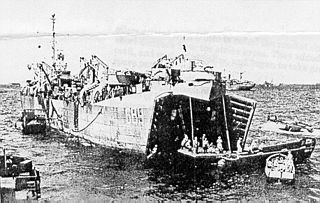USS ''LST-84'' was one of the hundreds of Tank landing ships built during World War II to support amphibious military operations. Her role was to carry significant quantities of vehicles, cargo, and troops directly onto an unimproved shore. The ship was sponsored by Mrs. W. Raymond Brendel. The ship was constructed inland at Jeffersonville, Indiana, by the Jeffersonville Boat & Machine Co. as coastal ship yards were used to build larger naval vessels. The ship traversed the Ohio and Mississippi River to reach open water.

USS LST-504 was an LST-491-class tank landing ship built for the United States Navy during World War II. Renamed USS Buchanan County (LST-504) for counties in Iowa, Missouri, and Virginia on 1 July 1955, she was the only U.S. Naval vessel to bear the name.
USS LST-884 was an LST-542-class tank landing ship in the United States Navy. Like many of her class, she was not named and is properly referred to by her hull designation.

USS DeKalb County (LST-715) was an LST-542-class tank landing ship built for the United States Navy during World War II. Named after counties in six states, it was the only U.S. Naval vessel to bear the name.

USS LST-689 was an LST-542-class tank landing ship built for the United States Navy during World War II. Late in her career she was renamed Daggett County (LST-689)—after Daggett County, Utah, the only U.S. Naval vessel to bear the name—but never saw active service under that name.

USS Douglas County (LST-731) was an LST-542-class tank landing ship built for the United States Navy during World War II. Named after counties in 12 states, she was the only U.S. Naval vessel to bear the name.

USS Duval County (LST-758) was an LST-542-class tank landing ship built for the United States Navy during World War II. Named after counties in Florida and Texas, she was the only U.S. naval vessel to bear the name.

USS Esmeraldo County (LST-761) was an LST-542-class tank landing ship built for the United States Navy during World War II. Named after an erroneous spelling of Esmeralda County, Nevada, she was the only U.S. Naval vessel to bear the name.
USS Garfield County (LST-784) was an LST-542-class tank landing ship built for the United States Navy during World War II. Named after counties in Colorado, Montana, Nebraska, Oklahoma, Utah, and Washington, she was the only U.S. Naval vessel to bear the name.
USS LST-701 was an LST-542-class tank landing ship built for the United States Navy in World War II. Like many of her class, she was not named and is properly referred to by her hull designation.
USS LSM-216 was a LSM-1-class landing ship medium built for the U.S. Navy during World War II. Like many of her class, she was not named and is properly referred to by her hull designation.

USS LST-724 was an LST-542-class tank landing ship acquired by the U.S. Navy during World War II for the task of landing troops and supplies on enemy beachheads.
USS LST-713 was an LST-542-class tank landing ship built for the United States Navy during World War II.

USS LST-449 was a United States Navy LST-1-class tank landing ship used in the Asiatic-Pacific Theater during World War II.

USS LST-929/LST(H)-929 was an LST-542-class tank landing ship in the United States Navy. Like many of her class, she was not named and is properly referred to by her hull designation.

USS LST-931/LST(H)-931 was an LST-542-class tank landing ship in the United States Navy. Like many of her class, she was not named and is properly referred to by her hull designation.

USS LST-940 was an LST-542-class tank landing ship in the United States Navy. Like many of her class, she was not named and is properly referred to by her hull designation.

USS LST-943 was an LST-542-class tank landing ship in the United States Navy. Like many of her class, she was not named and is properly referred to by her hull designation.

USS LST-944 was an LST-542-class tank landing ship in the United States Navy. Like many of her class, she was not named and is properly referred to by her hull designation.

USS LST-716 was an LST-542-class tank landing ship in the United States Navy during World War II. She was transferred to the Republic of China Navy as ROCS Chung Chien (LST-205).













